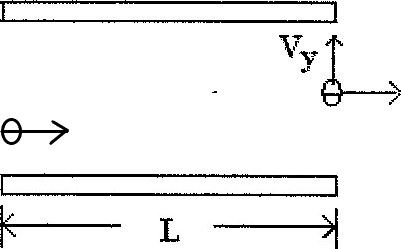An electron moves initially to the right as it enters a region between two parallel plates that have charges of equal magnitude and opposite sign. The initial horizontally directed speed is 6.00 x 106 m/s as shown by the arrow at the left end of the plates. The uniform electric field between the plates has magnitude E 12.00 N/C. The time the electron spends between the plates is t 0.500 µs. When the electron finally exits the region between the plates, the electron has picked up a y-component of velocity Vy shown by the vertical arrow at the right end of the plates. Let the positive y-direction be upward and the positive x-direction be rightward. (i) Which plate is positive, the bottom or the top one? Explain. (ii) What is the direction of the electric field between up or down? Explain. (iii) What is the value of Vy? The electron mass is m= 9.11x10-31 kg and the charge is -1.60x10-19 C. (iv) What is the length L of the plates?
An electron moves initially to the right as it enters a region between two parallel plates that have charges of equal magnitude and opposite sign. The initial horizontally directed speed is 6.00 x 106 m/s as shown by the arrow at the left end of the plates. The uniform electric field between the plates has magnitude E 12.00 N/C. The time the electron spends between the plates is t 0.500 µs. When the electron finally exits the region between the plates, the electron has picked up a y-component of velocity Vy shown by the vertical arrow at the right end of the plates. Let the positive y-direction be upward and the positive x-direction be rightward.
(i) Which plate is positive, the bottom or the top one? Explain.
(ii) What is the direction of the electric field between up or down? Explain.
(iii) What is the value of Vy? The electron mass is m= 9.11x10-31 kg and the charge is -1.60x10-19 C.
(iv) What is the length L of the plates?

Given that:

Trending now
This is a popular solution!
Step by step
Solved in 4 steps with 1 images









